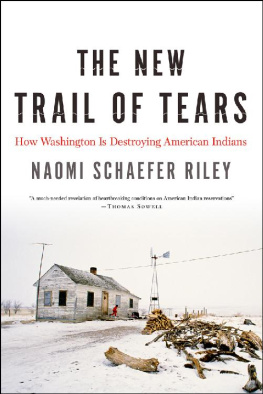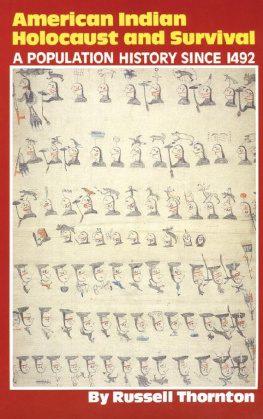When people ask me how I came to write a book about American Indians, I can only say anger. For years, I had read about the poverty, suicide, abuse, and alcohol and drug problems on reservations with a deep sense of sadness. I had assumed, as many readers had, that little could be done about these problems. But when I attended a conference at the Property and Environment Research Center in 2013, it became clear that things were both more and less hopeless than I had imagined.
The people I met there a group of incredibly smart, tenacious professors, leaders, and reformers had spent their lives fighting for their people to fix a broken system in the face of long odds. I am indebted to Terry Anderson for allowing me to be a part of that group.
Meeting and getting to know Ivan Small, Ben Chavis, Manny Jules, and Andr Le Dressay has been a rare privilege, and I cannot thank them enough for the time they spent with me and the efforts they expended to show me their hardest problems and their best solutions. I can only hope I have told their stories with the care they deserve.
This project would not have been possible without the support of the Searle Trust and the Randolph Foundation. I am deeply grateful to Kim Dennis and Heather Higgins, who trusted me with this sensitive and vexing topic.
And I am deeply grateful to my family. This book has been informed by a deep love and respect for American history, politics, and culture that my parents instilled in me from a young age. I hope that I can pass on some of that to my children. In the meantime, I thank Emily, Simon, and Leah for their patience and love. And thanks above all to my husband Jason, my best critic and my best friend.
A NOTE ON THE TYPE
THE NEW TRAIL OF TEARS has been set in Le Monde Livre. Designed in 1997 by Jean-Franois Porchez, Le Monde Livre adapts for book typography the award-winning 1994 type family Porchez created for Frances Le Monde newspaper, types now called Le Monde Journal. While the Journal types were specifically intended to be used at small sizes, the Livre family is suitable for larger, less dense settings planned for longer reading. The family was subsequently expanded with a more decorative variation (Le Monde Classic) and a sans-serif (Le Monde Sans). Graced with both style and readability, all of the Le Monde types display Porchezs considerable skill as a designer of typefaces and his deep knowledge of typographic history, particularly the rich heritage of French types from the sixteenth through nineteenth centuries.
DESIGN & COMPOSITION BY CARL W. SCARBROUGH
ITS FREE MONEY! a Crow legislator by the name of Karl Little Owl tells Ivan Small. Small, an older man who has known Little Owl since he was a child, laughs skeptically. Really? Hows that?
We didnt have to spend a dime of the tribes funds on this.
A good thing, Small replies, chuckling, since the tribe doesnt have any money.
Were standing just outside a tent where a ceremony to mark the breaking of ground on Apsaalooke Warrior Apartments is about to begin. The first development project on the Crow reservation in about a decade, Apsaalooke Warrior Apartments will be a 15-bed veterans home perched on a hill overlooking Crow Agency, the reservations political center. A couple of miles from the battlefield where Custer made his last stand, the home will no doubt be a reminder of Indians Pyrrhic victory here in Montana and the fact that it was short-lived. Soon after the Battle of the Little Bighorn, the U.S. Army succeeded in removing the remaining Indians from their land and putting them on reservations. In recent times, the policies that resulted in the mass extinguishment of Indian lives have been replaced by policies that result in their mass impoverishment and an existence circumscribed by violence and tragedy.
Here, under the tent, though, theres great celebration. Representatives of the Bureau of Indian Affairs, the state of Montana, and the tribal leadership are present. One person after another takes the podium to congratulate the individuals who spearheaded this development, applied for the grants, and waded through the bureaucratic morass (though no one dares call it that) to get this project off the ground. After about a dozen speeches, the four tribal leaders don feathered bonnets and sing a traditional song in their native language. Then each takes a golden shovel and turns over a piece of the soil.
At a cost of just under $8 million, the development wouldnt have been possible without a combination of federal, state, and private donations. The Crow tribe is broke, as Small observes, for a variety of reasons. Theres next to no economic activity on the reservation. In this desolate area in southeastern Montana, the unemployment rate is 47 percent (when you include people who have given up looking for jobs). The people who are employed almost all work for the tribal government.
And then theres this: the tribe, according to its leadership, owes the Department of Housing and Urban Development about $3 million. In the 1990s, HUD built most of the homes on the reservation, and the tribal leadership promised to exact a small monthly payment from each homeowner. Conrad Stewart, who used to work in the tribal housing office and now chairs the Natural Resources Infrastructure Committee for the Crow tribe, says that the payments were to be between $20 and $30 a month.
But then the tribe members, among them people in Smalls own extended family, refused to pay. Instead, Stewart says, When the tribe tried to go and recoup some of the money, they made threats. They said the tribe should pay for this. And the tribe has been paying for it [ever since].
Now the situation is getting bleaker. HUD, the tribal leaders tell me, refuses to build any more homes until the money is paid back. And so no homes are being constructed or repaired. Instead more and more people are moving into each small trailer home. The result is that 75 percent of tribal members between the ages of 18 and 40 dont have homes, according to Stewart.
Stewart blames part of this problem on the tribal governments lack of forethought. They were thinking about the short term, because a lot of times the administration they campaigned and then they got that one year to do something. Well, the next year its campaign season again. Tribal governance was no doubt an issue here. And the Crow tribe has taken steps to improve the situation. In 2001, it instituted four-year terms instead of two-year terms for the chair and other executive positions. Now we have three years of business and one year of campaigning, notes Stewart with forced optimism.
Even so, when the tribal government attempted to pass legislation that would require people to pay their debt to HUD, Stewart says, the old-timers were telling people, You do this and then theyre going to take all our homes and then theyre going to kick everybody out on the streets. Everyone will be homeless. Fourteen versions of the financial protection and procedures laws intended to address this situation were reviewed before one was passed. Says Stewart of this legislative ordeal: These people would cut your throat.
Of course, for anyone with a basic understanding of economics and political science, nothing in this story is surprising. If your political representative is also your landlord and you dont feel like paying your rent, youll vote him out of office. But when you do that, itll affect both your own ability to get credit and others ability to convince someone to build them a home.
But what choice do Crows have? Almost no one on the reservation can afford to build a home, because no one can get a mortgage. And no one can get a mortgage because the property on the reservation is held in trust by the federal government and most of its owned communally by the tribe. Which means, effectively, that no bank could ever foreclose on a property, because the bank cant own reservation land.
Next page



